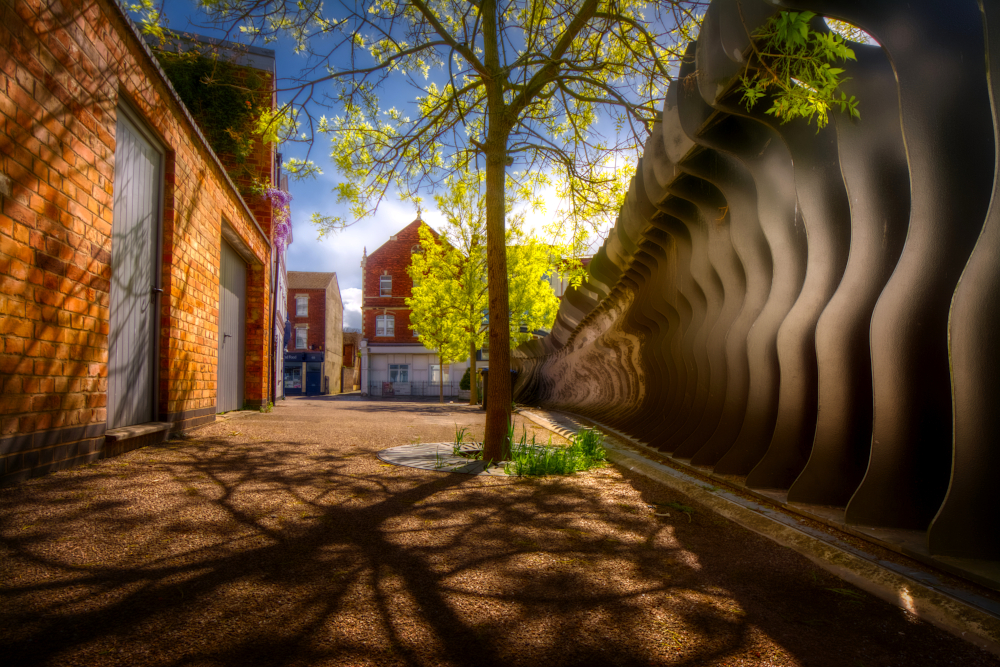Loading Images
Please bear with us...
Information
Southgate Street is one of the four cardinal streets that have survived from Gloucester's Roman origins. Now pedestrianised from where the south gate entrance to the city once stood, it meets its west, north and east siblings in the centre of Gloucester at The Cross.
In its original Roman form the road that became Southgate Street ran from the gate in the city wall to a forum that extended down from the centre. The Romans abandoned the city in the early 5th century, and after the city's subsequent reoccupation by the Saxons the street was extended in the 10th century through the remains of the forum to the centre. It had become known as Southgate Street by the mid-12th century. Excavations have unearthed the archaeological remains of the forum near the top of Southgate Street, along with pieces of a bronze equestrian statue. The spot is now marked by a modern statue commissioned by Gloucester Civic Trust of the Roman Emperor Nerva, in whose reign the legionary fort was transformed into one of only four colonia – inhabited by retired legionaries who enjoyed full Roman citizenship – to be established in Roman Britain.

Former Kimbrose Lane leading to the site of the south gate, with modern artwork to the right on the line of the Roman wall.
By the 18th century the south gate had become an impediment to traffic and was dismantled (its wooden gate is currently stored in the Folk of Gloucester on Westgate Street). The area where the gate once stood is marked now by the Kyneburgh Tower and Wall metal-sculpture artworks, the latter on the line of the Roman wall. A segment of the Roman wall can be seen in the furniture store on the corner of Southgate Street and Parliament Street.
The 18th century had begun with the union of England and Wales with Scotland to form the United Kingdom, saw the North American colonies break away to form their own union, and ended with revolutionary French peasantry ensuring that aristocratic French heads were no longer united with aristocratic French bodies.
In Gloucester, the century was a good deal less tumultuous. The population increased modestly, from just under 5,000 in 1710 to just over 7,500 in 1801. The city's largely stagnant economy was based mostly on the manufacture and supply of clothing to the region, and the two most common trades involved victuals and inns. The majority of listed properties that line Southgate Street today were originally built as relatively modest shops and dwellings in this period.
About half way up Southgate Street, though, the 14th century shines like a beacon in the form of the honeyed stones of St. Mary de Crypt. Originally built in the 12th century, the church was described in 1401 as like new after a substantial rebuild. The only surviving 12th-century feature visible is the moulding above the entrance on Southgate Street, designed to divert rainwater away from the door.
Next to the church is the original home of the Crypt Grammar School, built in 1539. A former pupil at this school was George Whitefield, born 1714 at the now long since vanished Bell Inn on Southgate Street. He became one of the founders of Methodism, and preached his first sermon at St. Mary de Crypt in 1736. His old school includes an arched entrance to Marylone – one of Gloucester's earliest streets which, when originally laid down by the Saxons, ran all the way to the city wall, rather than just the length of St. Mary de Crypt as it does now.
The 16th century of the school also still lurks across the road in the form of Robert Raikes' House. The property was built in the mid to late 16th century as a merchant's house. Robert Raikes was another Crypt-educated son of Gloucester and pioneer of the Sunday School movement. He inherited the Gloucester Journal after the death of his father in 1757, and moved first the printing business and then his family into the house which today accommodates a pub.
In the mid-17th century, as the dust settled on the English Civil War and Gloucester returned to the royal fold, Alderman Thomas Yate had a house built with an elaborate wooden facade on Southgate Street. Unlike the walls that confounded King Charles I during the siege of Gloucester some twenty years previously (which his vengeful son King Charles II ordered pulled down in 1661), Yate's house is still there today, the grade I Nos. 9–9a.
The 19th century began with a Napoleonic tide flowing then ebbing across Europe and went on to see uninterrupted growth in Gloucester, spurred by the completion in 1827 of the canal and docks. By 1881 the city's population had risen to over 36,000, though from the middle of the century most of the development occurred outside the municipal boundary. On Southgate Street this period is represented in the Historic England listings by Nos. 12–18, built in the 19th-century on the west side near The Cross (there are also some listed buildings dating to the 19th century on Commercial Road at the bottom of today's pedestrianised zone).
On the other side, the trip up Southgate ends a little farther up with the youngest listed building on the street. The 1904-built No. 5 is still occupied by Baker the clockmaker, for which business the property was built; the automata above the entrance, representing Father Time and the four nations of the UK, still chime out the hour.
44 Southgate Street (New County Hotel)
68–70 Southgate Street (Black Swan Hotel)